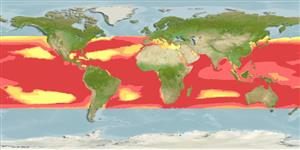Environment: milieu / climate zone / depth range / distribution range
Écologie
marin; saumâtre; océanodrome (Ref. 51243); profondeur 0 - 85 m (Ref. 13608), usually 5 - 10 m (Ref. 40849). Subtropical; 21°C - 30°C (Ref. 26); 50°N - 40°S, 180°W - 180°E (Ref. 54341)
Atlantic, Indian and Pacific: in tropical and subtropical waters. Highly migratory species
Length at first maturity / Taille / Poids / Âge
Maturity: Lm 55.8, range 35 - 93.1 cm
Max length : 210 cm TL mâle / non sexé; (Ref. 9846); common length : 100.0 cm TL mâle / non sexé; (Ref. 3390); poids max. publié: 40.0 kg (Ref. 30874); âge max. reporté: 4 années (Ref. 2885)
Épines dorsales (Total) : 0; Rayons mous dorsaux (Total) : 58 - 66; Épines anales: 0; Rayons mous anaux: 25 - 31; Vertèbres: 31. This species is distinguished by having the following characters: mature males with prominent bony crest in front of the head; greatest body depth in adults less than 25% of standard length; tooth patch on tongue small and oval; single dorsal fin extending from above eye almost to caudal fin with 58-66 rays; a concave anal fin extending from anus almost to caudal fin; pectoral fin more than half of head length; lateral-line scales at least 200 (Ref. 9648). Colour of body metallic blue-green on the back (fading to grey with green tinge when dead), sides silver with golden sheen, and 1 row of dark spots or golden blotches running below dorsal fin and 1, 2, or more rows on and below lateral line, some scattered irregularly; dorsal and anal fins
black, the latter with a white edge; pectoral fins pale; caudal fin silvery with a golden sheen; in juveniles, only tips of caudal-fin lobes white, pelvic fins black (Ref. 9648).
Adults are found in open waters but also near the coast (Ref. 9293, 11230). Form schools. Feed on almost all forms of fish and zooplankton; also takes crustaceans and squid (Ref. 2850). Sexual maturity is reached in 4-5 months (3 for captive fish) (Ref. 11441). Spawn in the open sea and probably approximate to the coast when water temperature rises (Ref. 9293). Eggs and larvae are pelagic (Ref. 6755). Attracting devices such as floating bundles of bamboo reeds or cork planks are used to concentrate dolphin fish before the nets are set. Marketed frozen (Ref. 9987) and fresh and is of high value (Ref. 9293). Caught by trolling and on tuna longlines; also occasionally with drift nets (Ref. 9846).
In East African waters, spawning season may last from March to early June and spawning occurs inshore. In the western Pacific, sex ratios were about equal during spawning season. Spawning in the western Atlantic occurs over an extended period of time.
Spawn naturally in captivity without artificial inducement (Ref. 41779).
Palko, B.J., G.L. Beardsley and W.J. Richards, 1982. Synopsis of the biological data on dolphin-fishes, Coryphaena hippurus Linnaeus and Coryphaena equiselis Linnaeus. FAO Fish. Synop. (130); NOAA Tech. Rep. NMFS Circ. (443). (Ref. 26)
Statut dans la liste rouge de l'IUCN (Ref. 130435)
Menace pour l'homme
Reports of ciguatera poisoning (Ref. 30911)
Utilisations par l'homme
Pêcheries: hautement commercial; Aquaculture: commercial; pêche sportive: oui
Outils
Fatal error: Uncaught mysqli_sql_exception: Too many connections in /var/www/html/includes/speciessummary.lib.php:2104
Stack trace:
#0 /var/www/html/includes/speciessummary.lib.php(2104): mysqli->__construct()
#1 /var/www/html/summary/SpeciesSummary.php(1787): checkRecordDisplayFBQuizV2()
#2 {main}
thrown in /var/www/html/includes/speciessummary.lib.php on line 2104
